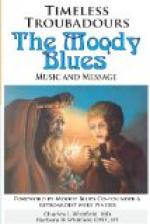A poetical form which preserves some trace of its popular origin is the pastorela[15] or pastoral which takes its name from the fact that the heroine of the piece was always a shepherdess. The conventional opening is a description by a knight of his meeting with a shepherdess, “the other day” (l’autrier, the word with which the poem usually begins). A dialogue then follows between the knight and the shepherdess, in which the former sues for her favours successfully or otherwise. The irony or sarcasm which enables the shepherdess to hold her own in the encounter is far removed from the simplicity of popular poetry. The Leys d’Amors mentions other forms of the same genre such as vaqueira (cowherd), auqueira (goose girl), of which a specimen of the first-named alone has survived. Of equal interest is the alba or dawn-song, in which the word alba reappeared as a refrain in each verse; the subject of the poem is the parting of the lovers at the dawn, the approach of which is announced by a watchman or by some faithful friend who has undertaken to guard their meeting-place throughout the night. The counterpart of this form, the serena, does not appear until late in the history of Provencal lyric poetry; in the serena the lover longs for the [34] approach of evening, which is to unite him with his beloved.
Other forms of minor importance were the comjat in which a troubadour bids a lady a final farewell, and the escondig or justification in which the lover attempts to excuse his behaviour to a lady whose anger he had aroused. The troubled state of his feelings might find expression in the descort (discord), in which each stanza showed a change of metre and melody. The descort of Raimbaut de Vaqueiras is written in five dialects, one for each stanza, and the last and sixth stanza of the poem gives two lines to each dialect, which Babel of strange sounds is intended, he says, to show how entirely his lady’s heart has changed towards him. The ballata and the estampida were dance-songs, but very few examples survive. Certain love letters also remain to us, but as these are written in rimed couplets and in narrative style, they can hardly be classified as lyric poetry.
In conclusion, a word must be said concerning the dispute between two schools of stylists, which is one of the most interesting points in the literary history of the troubadours.[16] From the earliest times we find two poetical schools in opposition, the trobar clus (also known as car, ric, oscur, sotil, cobert), the obscure, or close, subtle style of composition, and the trobar clar (leu, leugier, plan), the clear, light, easy, straightforward style. Two or three causes may have [35] combined to favour the development of obscure writing. The theme of love with which the chanso_ dealt is a subject by no means inexhaustible; there was




